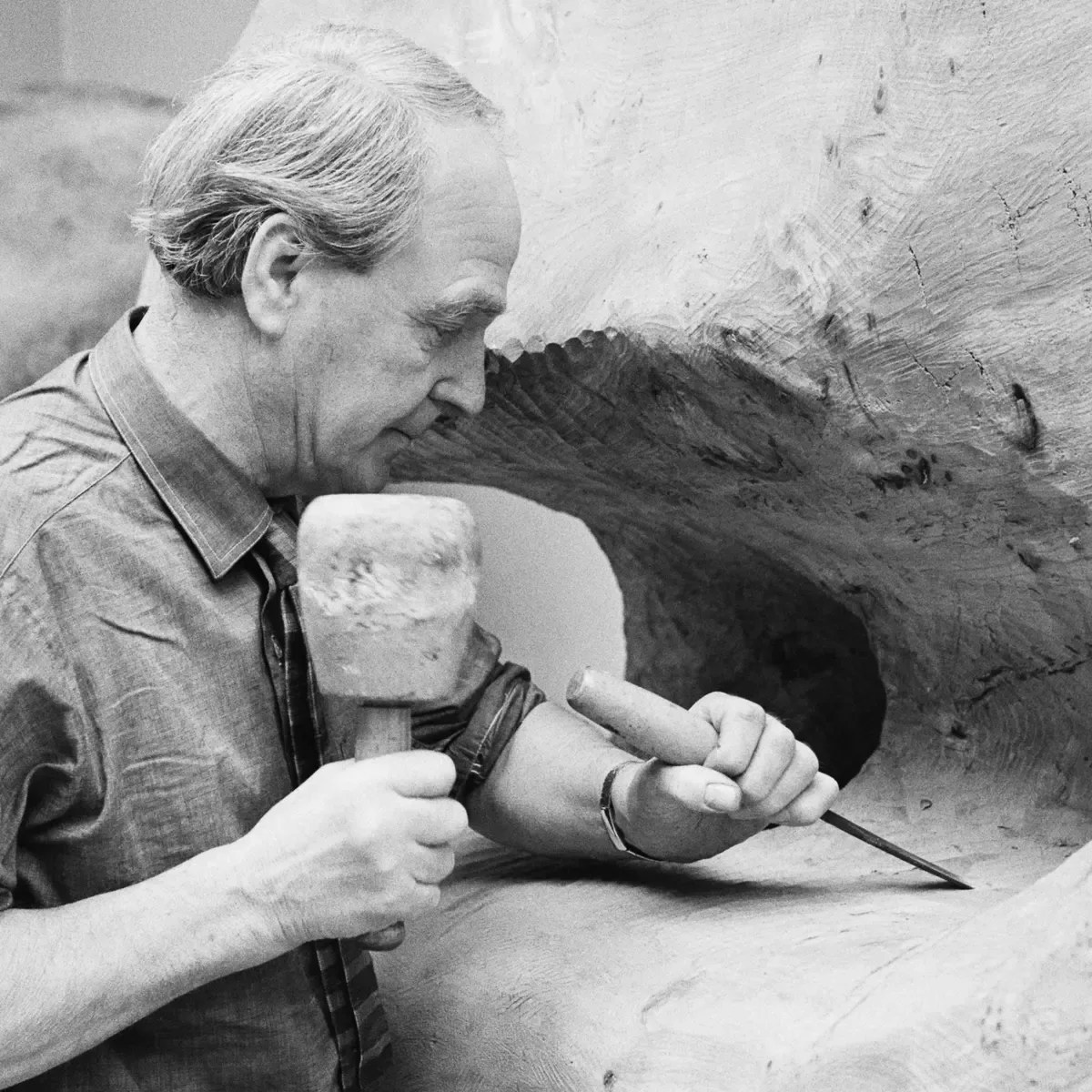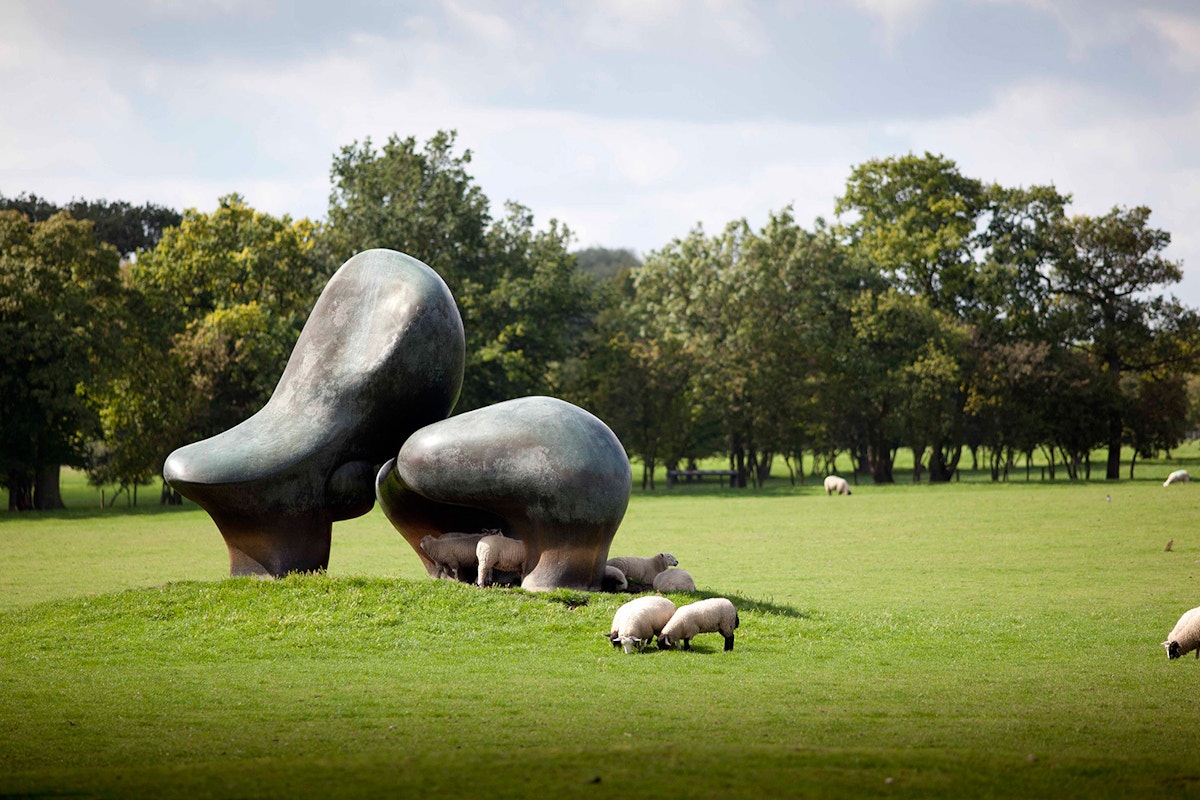Henry Moore
Henry Moore was born on July 30, 1898, in Castlefield, West Yorkshire in the north of England. He was the seventh of eight children born to a coal-mining family who encouraged their children to pursue an education. His elementary school teacher, John Holland, was the first to see that Henry possessed an artistic ability. When he was eleven, his Sunday School teacher spoke about Michelangelo as the ‘greatest sculptor that ever lived’. From that moment on, Henry decided that he wanted to follow in his footsteps and so, the story of Henry Moore begins and his rise to become one of the most important artists of the 20th century.
After serving in WWI, Henry was given a scholarship to study at Leeds School of Art, where he met fellow sculptor Barbara Hepworth who became a lifelong friend. After two years at Leeds, he attended The Royal Academy of Art in London where he later became an instructor for seven years until a vicious campaign against his modernist aesthetic was considered too unconventional and he resigned. In April 1931, the Morning Post wrote “Frankly, we think that Mr. Moore’s work is a menace from which students at the Royal College should be protected".


Henry Moore, Stringed Figure
Moore, who had received public acclaim, was not deterred from his leaning towards abstract form. He was a self-acclaimed collector of things that he found – shells, stones, driftwood, and bones. They became the basis for his abstract drawings and sculptures. Moore also became more interested in non-European art, exploring Surrealism, especially the work by Alberto Giacometti and Pablo Picasso. His string sculptures, created between 1937-39, were an experiment in dissecting interior forms and negative space. He was excited by “the ability to look through the strings … and to see one form within another".

Henry Moore Untitled XLVIII (Shelter Sketchbook) , 1967
On September 3rd, 1939, the United Kingdom declared war on Germany, an event that deeply affected Moore and his work as an artist. In an interview, he described walking home one evening and seeing crowds of people camped out on the train platforms of London’s Underground tube. He wrote, “I had never seen so many rows of reclining figures and even the holes out of which the trains were coming seemed to me like holes in my sculptures”. Moore showed a few of his drawings to his friend, Kenneth Clark, head of the War Artists Advisory Committee. He immediately commissioned him as an official war artist. Many of his sketches were from his experiences in London’s East End of the city, with Liverpool Street station as his favourite site to visit. His sketches of mothers and children, as well as reclining figures, became a recurring influence in his work. Moore described his drawings “like the chorus in a Greek drama telling us about the violence we don’t actually witness”. The Shelter Drawings became a symbol of the hardship of the people sheltering during the Blitz when over 40,000 Londoners were killed and over 50,000 seriously injured. During 57 consecutive nights bombs fell on London. In one night alone, over 400 bombers appeared in a massive raid. Two million - approximately sixty percent – of homes were damaged or destroyed. Moore’s drawings captured the raw emotions of fear and anxiety but also resilience.

The Archer Sculptor Henry Moore (left) and former Toronto Mayor Phil Givens at controversial work's unveiling in 1967
After the war, Moore returned to producing public sculptures and commissioned pieces. Moore wanted his sculptures to be part of people’s everyday lives. He truly believed they could change communities and be a humanizing influence. He is probably best known for his sculptures that are displayed around the world. “Everything I do, I intend to make on a large scale. Size itself has its own impact, and physically we can relate more strongly to a big sculpture than a small one.” He would often make a maquette only three or four inches in his hand and envision it on a monumental scale.
By the 1950’s, Moore was firmly established as one of the world’s greatest sculptors. In 1966, Toronto’s mayor, Philip Givens wanted to show the world that Toronto was a rising power; a cosmopolitan city. Having a Henry Moore sculpture was to be ‘the dawn of a new era’. While the City Council opposed the purchase, Givens spearheaded a campaign to raise the money from the private sector. This made a great impression on Moore. While the original agreement was for $120,000, Moore accepted $100,000. It was unveiled on October 27th, 1966. Toronto’s Globe and Mail newspaper named it “Henry Moore’s big bronze whatchamacallit”. Within two days over fifty thousand people came to see the controversial art installation making it one of the city’s most loved landmarks.
When Moore came to Toronto in 1967, he was impressed with the city and Frank Gehry’s dramatic plans for the redevelopment of the Art Gallery of Ontario. An agreement was reached that his plasters would be protected and never used for unauthorized casts after his death. In 1974, The Henry Moore Sculpture Center opened in a room designed by Moore who specifically asked that it be bathed in natural light from massive skylights above. Today the AGO is home to 141 sculptures, 75 drawings and 712 prints. It is one of the world’s most beautiful presentations of modern sculpture.

Photo by Liz Metcalfe

Photo by Liz Metcalfe

Henry Moore, The Show Sheep, 1974, Tate, London, UK.
Henry Moore continued his work until his death in 1986 at the age of eighty-eight. His studio, Hoglands, in Perry Green, Hertfordshire, was his home for forty years. While he primarily was a sculptor during this time, he also continued to sketch. His studio had a huge glass window that looked onto a farmer’s field. He noticed that when he tapped the window, sheep would congregate around it. His longtime friend Lord Kenneth Clark described his sketches - “We expect Henry Moore to give a certain nobility to everything he draws; but more surprising is the way in which these drawings express a feeling of real affection for their subject.” In 1972 Moore presented a portfolio of his sheep drawings to his daughter Mary and subsequently published in 1980 by Thames & Hudson.

Henry Moore. Sheep Piece 1971 to 1972. Hertfordshire United Kingdom

The work of Henry Moore will always be an inspiration. In 2020, Sarah Burton, Alexander McQueen’s Creative Director, reproduced his 1928 drawing ‘Three-Quarter Figure’ to life-size so that "the wearer would inhabit the artwork in its entirety; the figure would be brought to life". The Henry Moore Foundation has also worked with Christopher Bailey, chief Creative Director of Burberry on a collection in 2017 , and Paul Smith in 2011.
Henry Moore will continue to influence the way we see the world and continue to be part of my family history and a very personal connection to my father.